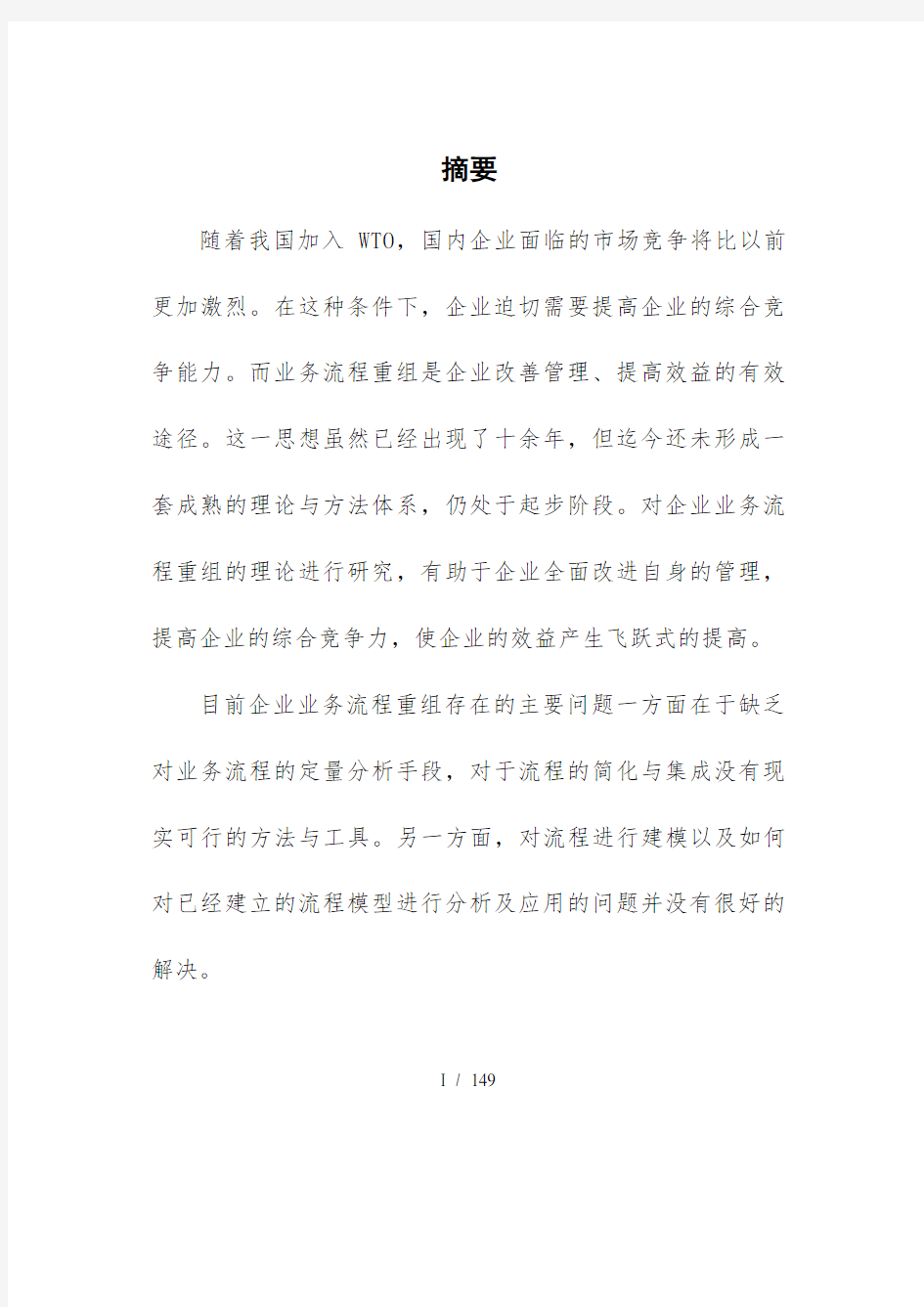业务流程建模


摘要
随着我国加入WTO,国内企业面临的市场竞争将比以前更加激烈。在这种条件下,企业迫切需要提高企业的综合竞争能力。而业务流程重组是企业改善管理、提高效益的有效途径。这一思想虽然已经出现了十余年,但迄今还未形成一套成熟的理论与方法体系,仍处于起步阶段。对企业业务流程重组的理论进行研究,有助于企业全面改进自身的管理,提高企业的综合竞争力,使企业的效益产生飞跃式的提高。
目前企业业务流程重组存在的主要问题一方面在于缺乏对业务流程的定量分析手段,对于流程的简化与集成没有现实可行的方法与工具。另一方面,对流程进行建模以及如何对已经建立的流程模型进行分析及应用的问题并没有很好的解决。
I / 149
本文试图从业务流程建模的角度出发,首先对业务流程的分解方法进行了研究,给出了活动的表示方法。并研究了活动的分类、活动之间的关系等内容。然后通过对Meta-Model、UC矩阵、PERT图、GRAI、Petri网模型等建模技术的研究与比较,分析了各种建模方法的特点及适用范围。由于这些建模方法都来自其它领域,并非专为业务流程所设计,所以本文以Petri网模型为例,对业务流程建模方法进行了改进研究。在此基础上,通过仿真系统对业务流程模型进行仿真,在仿真过程中计算流程的各种参数,从而为流程的简化与集成提供依据。最后,本文对仿真的运行管理和仿真的数据分析进行了研究。为业务流程模型仿真在流程简化和集成过程中的应用提供了可借鉴的方法。
关键词BPR;业务流程;业务流程重组;流程建模
Abstract
With our country joining WTO, domestic enterprises are facing further fiercer market competition than before. Under this kind of condition, enterprises need urgently to improve the comprehensive competitiveness. And it is the effective way that enterprises improve management, increase the benefit of the business process reengineered. this thought, Though has already been presented more than ten years, is still at the starting stage so far, and have not been formed a ripe theory and method system yet. To study the theory of Business Process Reengineering , will help enterprises improve one's own management all-side.
III / 149
Improve synthesized competitiveness of enterprise , enable benefit of enterprises to improve at a leap type .
At Present, the main problem of the enterprise business process reengineering, on one hand lie in lacking quantitative analysis means of business process, having no available methods to simplify and integrate the process. On the other hand, the problem to model the process and to analyses and use the existing model efficiently still existing.
This paper attempt to proceed from angle of the business process modeling, first to study the method of resolving business process, present the expression method of the activity, and studied the contents of
the classification of the activities, the relation between activities, etc. Then by studying and comparing of modeling technology, such as Meta-Model, UC matrix, PERT chart, GRAI, Petri network model, etc, we can analyse the characteristics of various kinds of modeling methods and scope of application. Because the modeling methods all come from other fields, which are not designed for business process specially, this paper takes Petri network model as an example to improve the process modeling method of the business. On this basis, we carry on emulation to the process model of the business with the emulation system, calculate various kinds of parameters of the procedure in the course of emulation, thus offer
V / 149
basis on which procedure simplifies and integrates. Finally, this paper has studied operation management and data analysis of emulation. The application while the process is simplified and integrated of emulation of model of procedure of the business has offered the method that can be drawn lessons from.
Keywords BPR; Business Process;
Business Process Reengineering; Process
Modeling
目录
摘要........................................... I Abstract ..................................... III
第1章绪论 (13)
1.1 课题背景 (13)
1.1.1 时代的需要 (13)
1.1.2 基于传统分工体制的业务流程的缺点 (15)
1.2 业务流程重组理论产生的背景 (17)
1.2.1 历史背景 (20)
1.2.2 时代背景 (21)
1.2.3 技术背景 (24)
1.3 业务流程重组理论的国内外研究现状 (26)
1.3.1 国外研究现状 (27)
VII / 149
1.3.2 国内研究现状 (29)
1.4 业务流程重组的反思与发展 (31)
1.5 本文研究的主要内容 (35)
第2章业务流程重组(BPR)的基本理论 (37)
2.1 业务流程的概念 (37)
2.1.1 业务流程的定义 (37)
2.1.2 业务流程的特点 (38)
2.2 业务流程重组的基本思想 (42)
2.2.1 业务流程重组的概念 (42)
2.2.2 业务流程重组的特征 (44)
2.2.3 业务流程重组的原则 (52)
2.2.4 业务流程重组的实质 (58)
2.3 实施业务流程重组的条件 (64)
2.4 现代信息技术与业务流程重组的关系 (66)
2.5 业务流程重组的方法 (68)
2.5.1 结果分析 (68)
2.5.2 技术分析(IT能力) (69)
2.5.3 活动去除 (70)
2.5.4 代理基准法 (71)
2.5.5 流程简化 (71)
2.6 本章小结 (72)
第3章业务流程建模方法研究 (73)
3.1 概述 (74)
3.1.1 对业务流程进行建模的目的 (74)
3.1.2 业务流程模型的特征 (75)
3.1.3 业务流程的建模方法概述 (77)
3.2 流程分解 (79)
3.2.1 流程的结构 (79)
IX / 149
3.2.2 活动的表示 (81)
3.2.3 活动的分类 (85)
3.2.4 活动之间的关系 (88)
3.2.5 业务流程图 (88)
3.3 业务流程的结构模型 (92)
3.3.1 业务流程的Meta模型 (92)
3.3.2 利用UC矩阵对流程的结构建模 (101)
3.4 业务流程的状态模型 (104)
3.4.1 PERT模型 (104)
3.4.2 GRAI模型 (106)
3.4.3 Petri网 (110)
3.5 业务流程中信息流的建模方法 (114)
3.5.1 数据流程图(DFD图) (114)
3.5.2 IDEF0模型 (115)
3.6 本章小结 (117)
第4章业务流程建模方法改进与模型仿真研究 (119)
4.1 各种建模方法的优缺点 (119)
4.1.1 业务流程的结构建模方法的优缺点 (120)
4.1.2 业务流程的状态建模方法的优缺点 (122)
4.2 流程建模方法的改进研究 (125)
4.2.1 扩展的Petri网模型 (125)
4.2.2 对流程进行建模 (129)
4.3 流程模型仿真研究 (130)
4.3.1 对业务流程模型的仿真 (131)
4.3.2 仿真运行管理 (136)
4.3.3 仿真数据分析 (137)
4.4 本章小结 (138)
结论 (139)
XI / 149
参考文献 (142)
致谢............................... 错误!未定义书签。
